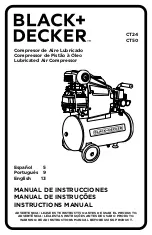
-4-
S
ETUP
& O
PERATION
Step 1)
Wire compressor to electrical box with disconnect or attach an applicable plug to end of power
cord. Compressor can be wired for 230 VAC/3 phase or 460 VAC/3 phase.
Note: Check the tag wire tied to the power cord for the proper voltage. If the voltage needs to be
changed, refer to the electric motor wiring diagram.
Step 2)
Check intake and outlet filters for excessive dirt and change if necessary. Set compressor in a
clean environment, away from hazardous dusts, mists, vapors, and fumes.
Step 3)
Use
only
constant flow Type-C respirators. Attach hose(s) and mask(s) to system before turning
the unit on. Failure to do so will cause internal motor damage.
Step 4)
Assure that electrical service amperage rating is in accordance with electrical motor specifica-
tions. Turn switch “on” and check for correct motor rotation. If rotation is incorrect, disconnect
power switch 2 power leads. Restart compressor.
Step 5)
With the compressor running, and respirators attached, loosen the relief valve lock nut. Adjust
outlet pressure to the setting recommended by the respirator manufacturer. Turn clockwise to
increase pressure, counterclockwise to decrease pressure.
Step 6)
With compressor running, open drain cock to drain any moisture which may be in receiver tank.
This should be done every 2 hours of operation. Close drain cock when complete.
DO NOT EXCEED 15psi OUTPUT PRESSURE
Turn knob of relief valve clockwise to increase pressure, counterclockwise to decrease pressure
and retighten lock nut. The unit is now operational.
Note: Do not back the adjustment knob all the way out while unit is pressurized. The loss of
internal parts may occur.























